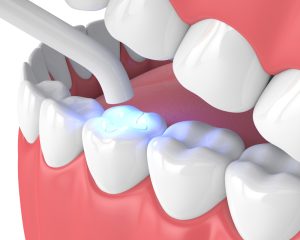What Are Glass Ionomer Fillings?
Glass ionomer fillings are made from a combination of glass powder and an organic acid, such as polyacrylic acid. They are known for their ability to bond chemically to tooth structure and their unique properties. Glass ionomers are often used for baby teeth and temporary fillings.
Types of Glass Ionomer Fillings
- Conventional Glass Ionomer: Conventional glass ionomer is self-cured and suitable for small to medium-sized cavities.
- Resin-Modified Glass Ionomer: Resin-modified glass ionomer dental fillings combine traditional glass ionomers with resin composite materials for improved strength and aesthetics.
- Compomer (Composite-Glass Ionomer Hybrid): Compomer glass ionomer fillings are a hybrid of composite resin and glass ionomer materials, offering better aesthetics than traditional glass ionomers.
Uses of Glass Ionomer Fillings
- Small to Medium-Sized Cavities: Suitable for repairing cavities in both adult and pediatric patients.
- Root Surface Cavities: Glass ionomer cement can be used to treat cavities caused by gum recession or root exposure.
- Pediatric Dentistry: Glass ionomer is commonly used in pediatric dentistry due to its fluoride-releasing properties and ease of application.
- Non-Stress-Bearing Areas: Glass ionomer cement is ideal for non-stress-bearing areas of the mouth, such as the front teeth and some premolars.
Advantages of Glass Ionomer Fillings
- Natural Appearance and Translucency: Glass ionomer fillings mimic the natural tooth structure’s translucency and color. This makes them a good choice for fillings in less visible areas like front teeth or between teeth.
- Fluoride Release: These fillings continuously release fluoride, a mineral that helps strengthen tooth enamel and prevent future cavities. This provides ongoing protection for your teeth.
- Minimal Tooth Preparation: Compared to other fillings, glass ionomer fillings often require less removal of healthy tooth structure during placement. This is beneficial for preserving tooth strength.
- Suitable for Non-Stress Bearing Areas: Due to their slightly lower strength, glass ionomer fillings are ideal for cavities in areas that experience less chewing pressure, such as between teeth or on the front teeth.
- Biocompatible and Well-Tolerated: Glass ionomer fillings are biocompatible, meaning they are unlikely to cause allergic reactions in the mouth. This makes them a good option for people with sensitive teeth.
Disadvantages of Glass Ionomer Fillings
- Limited Durability: Compared to fillings like composite resin or amalgam, glass ionomer fillings may not be as durable, especially in areas that experience frequent chewing pressure. They may chip or wear down faster in these areas.
- Sensitive to Moisture During Placement: Placing glass ionomer fillings requires a dry environment. Saliva contamination can affect the bonding process, so your dentist may need to use additional techniques to isolate the area.
- Weaker Than Materials Like Amalgam: Glass ionomer fillings generally have lower strength compared to traditional amalgam fillings. This makes them less suitable for large cavities or areas with high bite pressure.
- Aesthetic Limitations in Highly Visible Areas: While they offer a natural look, the shade of glass ionomer fillings may not perfectly match the surrounding tooth in highly visible areas like front teeth. Talk to your dentist about your desired aesthetics.
The Glass Ionomer Filling Procedure
- The glass ionomer filling procedure begins with a thorough dental examination and diagnosis, followed by tooth preparation and local anesthetic to ensure comfort. Dental sedation is also available if you’re feeling nervous or you’re in for a long procedure.
- The decayed portions of the tooth are removed, and the glass ionomer material is mixed and applied to fill the cavity, with optional light curing to enhance durability.
- After shaping and polishing the filling for a natural appearance, patients are advised on oral hygiene and dietary precautions. Regular follow-up appointments may be scheduled to maintain the filling’s integrity.
Costs
Patients can expect to spend between $75 to $200 on a single glass ionomer filling. They’re typically less expensive than composite fillings but more expensive than amalgam fillings. Factors that will influence the total cost include the size and location of the cavity, as well as your dental insurance coverage.
Frequently Asked Questions
They have a moderate lifespan, typically lasting around 5 to 10 years. However, their longevity can vary depending on factors like the location of the filling, oral hygiene practices, and the type of glass ionomer material used.
Yes, glass ionomer fillings are generally considered safe for dental use. They’re biocompatible, which means they’re well-tolerated by the body. Additionally, they release fluoride, which can help prevent tooth decay.
Call Us To Learn Your Options For Radiant Smile Restoration!
If you’re in need of a dental filling or seeking a long-lasting and natural-looking solution, don’t hesitate to contact Advanced Restorative Dentistry in Honolulu. Our experienced dentist, Dr. Nishime, is dedicated to providing high-quality, personalized care, including glass ionomer fillings and other restorative treatments. Call us today at (808) 732-0291 to schedule your appointment and discover how glass ionomer fillings can help restore the health and beauty of your smile.





